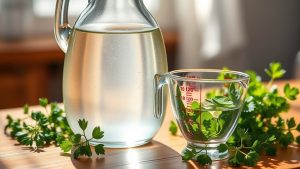
A gallon of water has a volume of approximately 3.78541 liters, which equals 128 fluid ounces. This measurement is essential in various applications, from cooking to scientific research. When considering space, remember that one gallon also takes up about 231 cubic inches. Understanding this measurement can help in areas like water storage and transportation. If you're curious about the weight and other details related to gallons, there's more to uncover on the topic.
When it comes to measuring liquids, understanding the volume of a water gallon is fundamental. A U.S. gallon, the standard measurement in the United States, equals approximately 3.78541 liters. This conversion is essential, especially when you're dealing with recipes or scientific measurements that require precise liquid quantities. If you need to visualize it in smaller units, know that one U.S. gallon contains 128 fluid ounces. So, when you pour a gallon of water, you're actually dispensing a substantial volume that can be broken down into these smaller measurements.
The weight of water is another important consideration. A gallon of water weighs roughly 8.33 pounds. This weight can influence your decision-making in various scenarios, such as when transporting water or understanding the load capacity of containers. If you're working on a project that requires a specific volume of water, knowing this information helps you make informed choices about materials and logistics.
In terms of space, one gallon is equivalent to 231 cubic inches. This measurement can be particularly useful when you're trying to determine how much space a gallon of water will occupy in a tank or other container. It's important to remember that the U.S. gallon differs from the Imperial gallon, which holds about 4.54609 liters. If you're traveling or working internationally, this distinction becomes crucial, as most countries utilize the metric system and measure liquids in liters.
When you think about practical applications, gallons play a significant role in everyday life. For instance, gasoline is commonly sold by the gallon in the U.S., making it easy to gauge fuel consumption. Similarly, bottled water often comes in gallon-sized containers, making it a familiar and accessible measurement for consumers.
In addition, gallons are used to measure pool water volume, which is critical for maintenance and chemical balance. Even household appliances like washing machines and water heaters often use gallons to indicate their capacity.
Understanding conversion factors can also enhance your grasp of gallons. For example, one gallon equals about 0.1337 cubic feet, which can be useful for engineering projects or space calculations. The U.S. gallon is a widely used measurement for liquids, particularly in the United States. When considering flow rates, gallons per minute is a standard measurement that helps you assess liquid movement in various systems.
As you navigate through different applications and contexts, remember that gallons can also be divided into types. The U.S. liquid gallon is most common for liquids, while the U.S. dry gallon is larger and used for dry materials. This differentiation can be important in specific industries, such as agriculture or manufacturing.
Conclusion
To conclude, a gallon of water holds precisely 3.785 liters, making it a fundamental unit for measuring liquids. Whether you're filling up a modern-day water bottle or using an old-timey bucket, knowing this volume helps in various practical situations. So, next time you're hydrating or cooking, remember that this classic measure still holds its weight in today's fast-paced world. Embracing the gallon can streamline your efforts, just like a trusty steed on a long journey.



